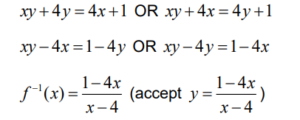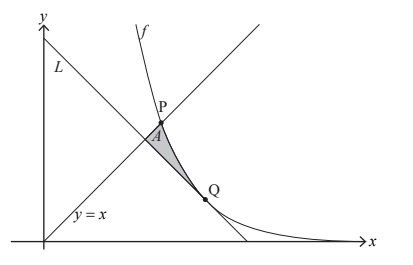Question:
The function f is defined by \(f(x)= \frac{4x+1}{x+4},\) where x ∈ R, x ≠ -4 .
(a) For the graph of f
(i) write down the equation of the vertical asymptote;
(ii) find the equation of the horizontal asymptote.
(b) (i) Find f -1(x).
(ii) Using an algebraic approach, show that the graph of f -1 is obtained by a reflection of the graph of f in the y-axis followed by a reflection in the x-axis.
The graphs of f and f -1 intersect at x = p and x = q, where p < q.
(c) (i) Find the value of p and the value of q.
(ii) Hence, find the area enclosed by the graph of f and the graph of f -1.
Answer/Explanation
Ans:
(a) (i) x =−4
(ii) attempt to substitute into \(\frac{a}{c}\) OR table with large values of x OR sketch of f showing asymptotic behaviour
y = 4
(b) (i) \(y=\frac{4x+1}{x+4},\)
attempt to interchange x and y (seen anywhere) 

Note: If the candidate attempts to show the result using a particular coordinate on the graph of f rather than a general coordinate on the graph of f, where appropriate, award marks as follows:
M0A0 for eg (2,3) → (- 2,3)
M0A0 for ( -2,3) → ( -2, -3)
(c) (i) attempt to solve f(x) = f-1 (x) using graph or algebraically
p = −1 AND q =1
Note: Award (M1)A0 if only one correct value seen.
(ii) attempt to set up an integral to find area between f and f−1

Question
Consider the function f defined by f (x) = 90e-0.5x for x ∈ R+ The graph of f and the line y = x intersect at point P.
Find the x-coordinate of P. [2]
The line L has a gradient of –1 and is a tangent to the graph of f at the point Q.
Find the exact coordinates of Q. [4]
Show that the equation of L is y = -x + 2ln45 + 2 . [2]
The shaded region A is enclosed by the graph of f and the lines y = x and L .

(i) Find the x-coordinate of the point where L intersects the line y = x .
(ii) Hence, find the area of A . [5]
The line L is tangent to the graphs of both f and the inverse function f –1 .
Find the shaded area enclosed by the graphs of f and f –1 and the line L . [2]
Answer/Explanation
Ans:
(a)
attempt to find the point of intersection of the graph of f and the line y = x
x = 5.56619… = 5.57
(b)
\(f'(x)=-45e^{-0.5x}\)
attempt to set the gradient of equal to -1
-45e -0.5x = -1
Q has coordinates \((2ln45,2) \)or \((-2 ln\frac{1}{45},2)\)
(c)
attempt to substitute coordinates of Q ( in any order) into an appropriate equation
y-2= -(x-2ln45)
OR
2= – 2 ln 45 + C
equation of L is y = – x+ 2ln 45 + 2
(d)
(i) x= ln45 + 1 (=4.81)
(ii) appropriate method to find the sum of two areas using integrals of the difference of two functions 
=1.51965… =1.52
(e) by symmetry 2 ×1.52
= 3.03930… = 3.04
Question
(a) Sketch the curve \(y = \left| {\ln x} \right| – \left| {\cos x} \right| – 0.1\) , \(0 < x < 4\) showing clearly the coordinates of the points of intersection with the x-axis and the coordinates of any local maxima and minima.
(b) Find the values of x for which \(\left| {\ln x} \right| > \left| {\cos x} \right| + 0.1\), \(0 < x < 4\) .
Answer/Explanation
Markscheme
(a)
 A1
A1
Note: Award A1 for shape.
x-intercepts 0.354, 1.36, 2.59, 2.95 A2
Note: Award A1 for three correct, A0 otherwise.
maximum = (1.57, 0.352) = \(\left( {\frac{\pi }{2},0.352} \right)\) A1
minimum = (1, – 0.640) and (2.77, – 0.0129) A1
(b) \(0 < x < 0.354,{\text{ }}1.36 < x < 2.59,{\text{ }}2.95 < x < 4\) A2
Note: Award A1 if two correct regions given.
[7 marks]
Examiners report
Solutions to this question were extremely disappointing with many candidates doing the sketch in degree mode instead of radian mode. The two adjacent intercepts at 2.59 and 2.95 were often missed due to an unsatisfactory window. Some sketches were so small that a magnifying glass was required to read some of the numbers; candidates would be well advised to draw sketches large enough to be easily read.
Question
Let \(f(x) = \frac{{{{\text{e}}^{2x}} + 1}}{{{{\text{e}}^x} – 2}}\).
The line \({L_2}\) is parallel to \({L_1}\) and tangent to the curve \(y = f(x)\).
Find the equations of the horizontal and vertical asymptotes of the curve \(y = f(x)\).
(i) Find \(f'(x)\).
(ii) Show that the curve has exactly one point where its tangent is horizontal.
(iii) Find the coordinates of this point.
Find the equation of \({L_1}\), the normal to the curve at the point where it crosses the y-axis.
Find the equation of the line \({L_2}\).
Answer/Explanation
Markscheme
\(x \to – \infty \Rightarrow y \to – \frac{1}{2}\) so \(y = – \frac{1}{2}\) is an asymptote (M1)A1
\({{\text{e}}^x} – 2 = 0 \Rightarrow x = \ln 2\) so \(x = \ln 2{\text{ }}( = 0.693)\) is an asymptote (M1)A1
[4 marks]
(i) \(f'(x) = \frac{{2\left( {{{\text{e}}^x} – 2} \right){{\text{e}}^{2x}} – \left( {{{\text{e}}^{2x}} + 1} \right){{\text{e}}^x}}}{{{{\left( {{{\text{e}}^x} – 2} \right)}^2}}}\) M1A1
\( = \frac{{{{\text{e}}^{3x}} – 4{{\text{e}}^{2x}} – {{\text{e}}^x}}}{{{{\left( {{{\text{e}}^x} – 2} \right)}^2}}}\)
(ii) \(f'(x) = 0\) when \({{\text{e}}^{3x}} – 4{{\text{e}}^{2x}} – {{\text{e}}^x} = 0\) M1
\({{\text{e}}^x}\left( {{{\text{e}}^{2x}} – 4{{\text{e}}^x} – 1} \right) = 0\)
\({{\text{e}}^x} = 0,{\text{ }}{{\text{e}}^x} = – 0.236,{\text{ }}{{\text{e}}^x} = 4.24{\text{ }}({\text{or }}{{\text{e}}^x} = 2 \pm \sqrt 5 )\) A1A1
Note: Award A1 for zero, A1 for other two solutions.
Accept any answers which show a zero, a negative and a positive.
as \({{\text{e}}^x} > 0\) exactly one solution R1
Note: Do not award marks for purely graphical solution.
(iii) (1.44, 8.47) A1A1
[8 marks]
\(f'(0) = – 4\) (A1)
so gradient of normal is \(\frac{1}{4}\) (M1)
\(f(0) = – 2\) (A1)
so equation of \({L_1}\) is \(y = \frac{1}{4}x – 2\) A1
[4 marks]
\(f'(x) = \frac{1}{4}\) M1
so \(x = 1.46\) (M1)A1
\(f(1.46) = 8.47\) (A1)
equation of \({L_2}\) is \(y – 8.47 = \frac{1}{4}(x – 1.46)\) A1
(or \(y = \frac{1}{4}x + 8.11\))
[5 marks]
Examiners report
[N/A]
[N/A]
[N/A]
[N/A]
